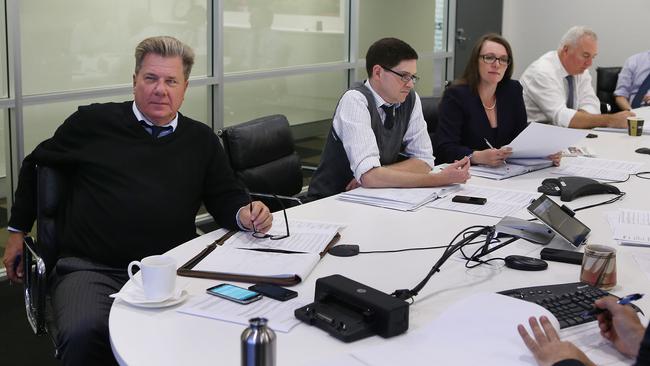Get off the ‘pro-cyclical’ publishing train wreck: Mitchell
THE Australian’s editor-in-chief Chris Mitchell has defended use of the “tummy compass” and attacked “pro-cyclical” newspaper decision-making.

THE Australian’s editor-in-chief Chris Mitchell has mounted a staunch defence of the “tummy compass” in a blistering attack against “pro-cyclical” management decision-making in the newspaper industry.
Mr Mitchell has also revealed The Australian’s advertising revenue has grown every month since February against the prior corresponding period and is on course to return to profit “having routed the Huns from MBA hipsterville”.
In an opinion piece published by media industry title AdNews, Mr Mitchell expressed amazement at “how many leaders keep resorting to failed pro-cyclical decision-making strategies”, urging managers to trust the benefits of instinct and experience.
“The relationship between news-breaking and analysis, circulation and demographic outcomes, ad rates and print and digital subscription revenues and eventually profits is not linear and does require a ‘tummy compass’,” Mr Mitchell writes.
He has been a consistent critic of the trend towards chief executives hiring young grad school consultants to make important business decisions rather than those with decades of publishing experience.
“An MBA really can’t tell a publisher what will sell and what demographic a change will appeal to. MBAs can only apply broad-brush cost containment principles. Consultants don’t really understand the complexity of your business,” he says.
While modern technology has opened up new avenues between media companies and the audience, Mr Mitchell argues that what hasn’t changed is the need for skilled teams of reporters and editors to produce “unique stories”.
He says the craft of journalism is still about ripping yarns, the insight of opinion pieces and compelling features.
“Yet in publishing until recently we have let the sharp haircuts loose and they have wreaked havoc,” he says.
“Not for the first time business graduates have forgotten the basic lesson of comparative advantage. Ours in the newspaper and digital news business is in breaking unique stories.”
In the headlong rush towards a digital future, publishing executives have failed to reap the lessons of the past, Mr Mitchell says.
“Just as TV did not kill radio, it did not kill afternoon newspapers,” he says. “And just as publishers acted pro-cyclically when confronted by threats from TV, they rushed to drop their pants before the challenge from online publishing.”
In fact, Mr Mitchell says the competitive Sydney afternoon newspaper market died because it abandoned its core news values.
He points out that the free afternoon commuter market is thriving, citing News Corp’s hugely successful MX franchise.
“How could publishers who were making huge profits from print sales and advertising have been so stupid as to put all their news online for free?” Mitchell writes.
“The most disruptive attack on our business model was our own pro-cyclical decision to give our journalism away for free to those not loyal enough to pay for it but keep ratcheting up cover prices and ad rates for those who remained loyal.”
Mr Mitchell outlines strategies to help publishers “get off the pro-cyclical train wreck that digital evangelists who did not really understand publishing have put us on”.
These includes dropping the reverse-publishing model adopted by once venerable mastheads like The Age and Sydney Morning Herald, which sees tyro reporters tweet instantly on events, based on trending Twitter topics, to generate stories for the next day’s paper
Mr Mitchell says apps are key to “lifting reader engagement and brand loyalty”, and cautions that while the future maybe desktop and mobile, “the eyeballs are moving there but the revenue is not”.
According to the recent Audit Bureau of Circulations third-quarter result, The Australian delivered a 17 per cent rise in year-on-year digital subscriptions.
Under Mr Mitchell’s editorship, The Australian was the first newspaper in Australia to launch a digital subscription model, a move that has since been adopted after initial resistance and criticism by other major publishers including Fairfax Media.
Mr Mitchell said the paper’s digital success is based on its commitment to quality journalism. “It still breaks more stories than the billion-dollar ABC and all the Fairfax titles combined,” he says.
“Break news across all platforms. Concentrate on complex tasks our skilled team can do better than any other outlet staffed by kids.
“And remember the rapid growth in digital revenue is growth of a pile of earnings still less than a tenth of total revenue on the Oz and a twentieth across our metros.”
Read the full piece.



